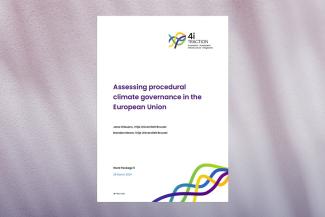
Gheuens, J.; Moore, B. (2024): Assessing procedural climate governance in the European Union. 4i-TRACTION Deliverable 5.3. Vrije Universiteit Brussel; Brussels.
Assessing procedural climate governance in the European Union
This report assesses the transformative nature of procedural governance mechanisms with different functions such as planning, participation and expert advice, using a previously developed assessment framework.
Summary
The report examines eight procedural governance mechanisms that seek to fulfil key procedural governance functions including planning, access to justice, decision-making, participation, monitoring and evaluation, and expert advice. The examined mechanisms are: the European Scientific Advisory Board on Climate Change, the Multilevel Climate and Energy Dialogues, the National Energy and Climate Plans, the social dimension of EU climate planning, integrated infrastructure planning, monitoring and evaluation of climate-related investments, access to justice, and climate policy integration.
Using a previously developed framework designed to assess the mechanisms’ potential for transformative change, the report analyses them on their: (1) overall effectiveness; (2) policy resilience; and (3) quality of implementation (Moore et al., 2023). The assessment was conducted using a variety of methods including document analysis and interviews. While there were some differences between the case studies, we can distinguish three overarching results.
Transformative potential on paper, but barriers to realising it
Three key cross-cutting results can be distilled from the comparative assessment of the case studies on the three criteria:
- The underlying legislation allows the governance mechanisms to carry out their functions, in principle, giving them a base level of overall effectiveness. Additionally, the centrality of the climate neutrality objective gives the mechanisms the potential for transformative change. However, barriers exist to integrating the mechanisms in the policy process, and the legislation at times provides too much flexibility which could lower their potential for transformative change.
- Transformative action is often impeded by ineffective implementation of the mechanisms. While the mechanisms’ design sets out certain obligations, these are not always implemented leading to a discrepancy between the functioning of the mechanisms on paper and in reality. This could point to inadequate follow-up and enforcement procedures. Moreover, insufficient resources, lack of transparency and of independence could further impose limitations on the extent to which the mechanisms are able to carry out their governance functions.
- Due to the review structure present in most governance mechanisms under investigation, they possess a relative high degree of policy resilience. Regular revisions could offer the opportunity to mitigate some of the aforementioned shortcomings and, hence, enable the governance mechanisms to fulfil their true potential. This is particularly promising for those mechanisms that have a more permanent and independent nature.
Cross-cutting lessons
The assessment of the selected governance mechanisms revealed three broad recommendations to improve the functioning and implementation of procedural governance mechanisms in the future:
- Set precise obligations that guide member states and other actors in successfully implementing the mechanisms. While flexibility allows for the governance mechanisms to be adapted to different national circumstances or infrastructures, too much flexibility results in their ineffective implementation. As such, clear (minimum) standards could help create consistency across processes and set a baseline for procedural quality which all relevant actors need to meet.
- Clarify the role of governance mechanisms in the policy process to increase their impact. This could allow for better focusing of limited resources to ensure that processes like those carried out for the MLCEDs, NECPs, and ESAB-CC reports, have a more useful impact on the policy process and, as a result, on the successful transformation toward climate neutrality. Moreover, a more formal role of the mechanisms in the policy process could also improve implementation through the creation of more follow-up expectations, for instance, by indicating when policymakers have to respond to the advice of the ESAB-CC.
- Provide adequate resources for governance mechanisms to carry out their functions and to have a transformative impact. This entails ensuring that mechanisms have enough funding, that they have access to the required data, and that they are involved in the policy process in a timely fashion.
Case Studies
- Case Study A: Faber et al. (2024). Fostering transformative climate governance? The potential of multilevel climate and energy dialogues.
- Case Study B: Von Homeyer et al. (2024). Public participation and the National Energy and Climate Plans (NECPs).
- Case Study C: Mähönen, M. (2024). Access to Justice in the EU's Procedural Climate Governance Framework: A Case Study of NECPs.
- Case Study D: Kögel, N. (2024). Policy integration: Enhancing the social dimension in climate policy planning instruments in the EU.
- Case Study E: Varis, K. (2024). The European Scientific Advisory Board on Climate Change.
- Case Study F: Humphreys, C. (2024). Monitoring and evaluating climate investments in the EU: Conceptual framework and case studies.
- Case Study G: Kampman et al. (2024). Stakeholder participation in infrastructure projects.
- Case Study H: Kulovesi et al. (2024). Climate policy integration.